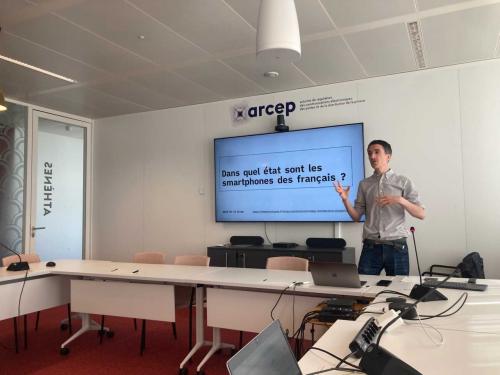
Presentation of a new study on broken and aging smartphones to the French regulation authorities
The study, based on a representative survey, shows that more than 40% of the French population lives with a malfunctioning smartphone, mainly due to software obsolescence reasons.
Some key take-aways from the study:
- Software is responsible for 60% of smartphone malfunctions.
- The most frequent hardware and software problems are: a worn-out battery (28%), saturated storage (23%) and slowness (21%).
- The problems appear early: half of them within a year of getting their smartphone, and a quarter just within the first three months.
- People live with annoying problems for a long time. Despite the inconvenience, only one third of problems are resolved, and another third are still present on the smartphone more than 2 years after they first appeared.
- Replacement is most often due to gradual deterioration of the device, rather than a sudden breakdown.
The presentation to the various ARCEP departments provided an opportunity to discuss regulatory options that go beyond updates to take account of other software factors such as storage management, slowness and software malfunctions, and the strategies of the smartphone industry. The study identified several levers for action, in particular aimed at designers, developers and designers of digital services:
- Implementing a software guarantee from smartphone manufacturers over several years.
- Make available lighter, less data-intensive applications to avoid saturating storage, compatible with limited computing performances to avoid slowness and preserve the battery.
- Make it easier to manage and clean up storage using software or hardware, and make the data produced by applications intelligible.
- Adding parameters to circumvent malfunctions and preserve the battery.
- Facilitate hardware and software repair and maintenance: extend the repair bonus to software problems, design hardware and software that can be repaired and maintained by end-users or independant repair shops.
Léa Mosesso, a research engineer in the SICAL team, co-piloted the design of the study and supervised the analysis of the results.
To find out more about the survey: https://limitesnumeriques.fr/travaux-productions/sondage-obsolescence-smartphones/
This study was carried out in collaboration with Telecom Paris, the University of Strasbourg, the University of Toulouse, de Vinci Research Center, the association Designers Ethiques, and with the support of the CNRS interdisciplinary department.
